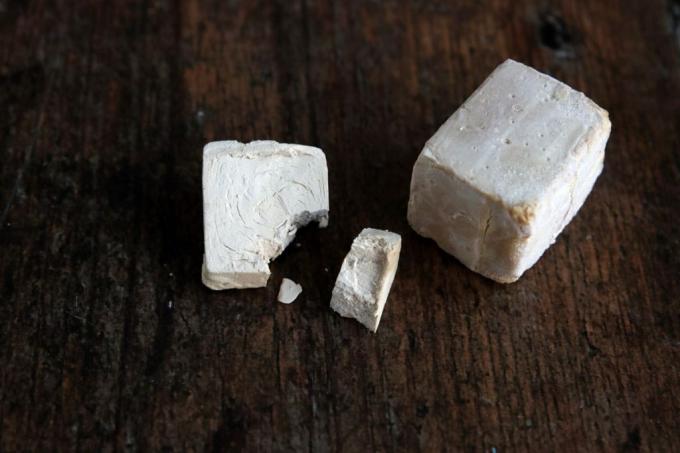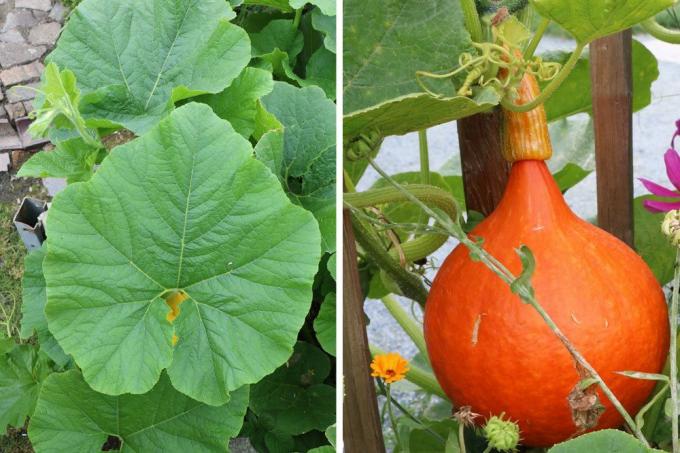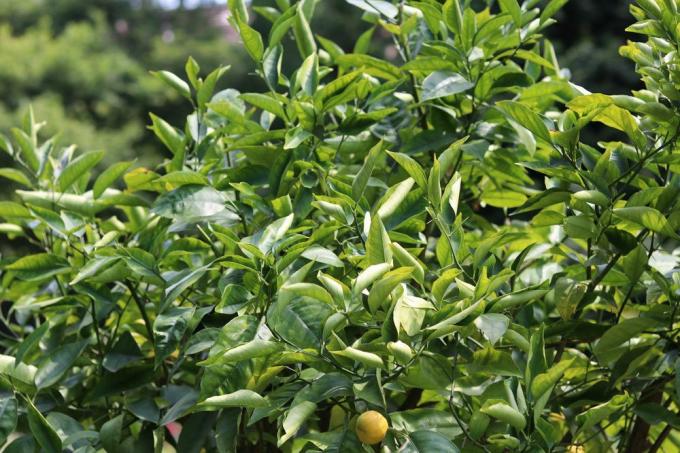
table of contents
- Contains important nutrients
- Preparation of the fertilizer solution
- Heavy eaters love yeast
- Plants from A - F
- Plants from G - J
- Plants from K - O
- Plants from P - R
- Plants from S - T
- Plants from U - Z
- frequently asked Questions
Our grandmothers already knew the benefits of yeast. Not only for baking or for our well-being, but also as fertilizer in the garden at home. You can find out everything about production and use below.
In a nutshell
- Heavy eaters especially love yeast
- Use as fertilizer, spray and compost accelerator
- Can be administered as fertilizer every 14 days
- Yeast only has an indirect effect on plants
- Yeast fertilizer can also be used for indoor plants
Contains important nutrients
Yeast is made from cultured yeast. These are unicellular yeasts. One gram of baker's yeast consists of up to a billion yeast fungi. Baker's yeast or brewer's yeast contains important nutrients such as:

- iron
- Folic acid
- Biotin
- niacin
- zinc
- Vitamins B1, B2 and B6
- magnesium
- Potassium and
- different proteins
When using yeast as a fertilizer in the garden, it does not work directly. In other words, it is not the plants that are directly supplied with the nutrients, but the microorganisms living in the soil. The administration of yeast stimulates them to decompose the constituents of the soil more quickly and to make them available to the plants as food.
Preparation of the fertilizer solution
There are two different ways to make a fertilizer solution from baker's yeast:
Fermented yeast solution
- 100 g baker's yeast
- 200 g of sugar
- 10 l of warm water
Manufacturing:
- Crumble the yeast
- mix with sugar
- slowly pour warm water
- mix well
- let ferment for a week
- Use diluted 1:10 with water

Not fermented yeast solution
- a cube of baker's yeast
- one liter of warm water
Manufacturing:
- Crumble the yeast
- Pour in some lukewarm water
- process everything to an even mass
- Add the rest of the water, stir
- let rest for an hour
- then use possible
Rainwater or potato water should be used with both fertilizer solutions if possible.
Tip: Dry yeast can also be used. This should always be dissolved in hot water before adding cold or lukewarm water.
Heavy eaters love yeast
The fertilizer solution is completely organic, environmentally friendly and odorless. It can also be administered every 14 days to once a month from spring to the end of summer. Heavy consumers in particular benefit from this. The baker's yeast can either be worked into the soil or added to the irrigation water. Below is a brief overview:
Plants from A - F
Eggplant (Solanum melongena)
Egg tree

- loose, humus soil
- Prepare the soil well
- enrich with compost
- warm, sunny, sheltered location
- regular watering
- 14 days fertilization with nettle liquid manure
- alternating with yeast fertilizer
Strawberries (Fragaria)

- location in full sun, sheltered from the wind
- loose, not too heavy, deep, humus-rich soil
- pH between 5.5 and 6.5
- Water sufficiently during dry periods
- loosen the soil regularly
- Mulching with dried grass clippings
- from May mulch layer of straw
- generally fertilize only after harvest
- however, administration of yeast fertilizer in spring
Tip: Fertilizer from baker's yeast has a positive effect on strawberry seedlings. These take root more quickly in the soil.
Plants from G - J
Geranium (pelargonium)

- popular in buckets and balcony boxes
- nutrient-rich, loose soil
- sunny location
- Fertilization every 14 days from May to September
- additional yeast fertilizer once a month
Cucumber (Cucumis sativus)

- Heavy Eater
- loose, humus soil
- Prepare the soil well
- Enrichment with compost
- sunny, sheltered place
- annual change of location necessary
- water and fertilize sufficiently
- Fertilize every 14 days after the flowers have set
- Apply a layer of mulch
- Yeast fertilizer once a month
Plants from K - O
Potatoes (Solanum tuberosum)

- medium heavy, deep soil
- Prepare the soil well
- enrich with compost
- sunny, warm place
- Planting in the same place only every four years
- sufficient watering during dry periods
- Avoid waterlogging
- fertilize regularly
- 14 days of potassium
- in addition, use of yeast fertilizer
Cabbage (Brassica)

- deep, nutrient-rich, humus soil
- should have good water storage
- sunny to partially shaded place
- Heavy Eater
- regular and sufficient watering
- especially in July and August
- Avoidance of waterlogging
- 14-day application of organic fertilizers such as horn meal
- Nettle manure is also ideally suited
- additionally pour yeast fertilizer
- regular soil loosening
- Apply a layer of mulch
Pumpkins (Cucurbita)

- Heavy Eater
- soil rich in nutrients and humus
- good soil preparation
- Incorporation of compost
- warm, sunny, sheltered place
- annual change of location
- only plant in the same place every five years
- water evenly
- Mulching with dried grass clippings or straw
- 14 days of fertilization alternating with nettle liquid and yeast fertilizer
Leek (Allium porrum)
leek

- humus and nutrient-rich, deep, moist soil
- good soil preparation
- enrich with compost
- sunny to partially shaded place
- regular soil loosening
- water regularly
- pile up
- this makes the shafts whiter and smoother
- at the same time protection against freezing through with winter leek
- every 2 to 4 weeks alternating administration of nettle manure and yeast fertilizer
Plants from P - R
Paprika (Capsisum annuum)

- loose soil rich in nutrients and humus
- good soil preparation
- Incorporation of compost or horn meal
- warm, sunny place
- additional fertilization with nettle liquid manure
- from mid-June to the end of August
- two to three times during this period
- Mulching with dried grass clippings
- once a month application of yeast fertilizer
Petunia (Petunia)

- Heavy Eater
- popular balcony plant
- special ferruginous petunia soil
- pH 5.5 is ideal
- alternatively half normal potting soil and half bog soil
- sunny, sheltered place
- water abundantly
- Do not over shower plants
- clean regularly
- Fertilize every 14 days
- in addition, addition of baker's yeast
Rose (pink)

- loose, nutrient-rich, humus-rich, well-drained, loamy-sandy soil
- sunny. airy place
- Water abundantly during dry periods
- Avoid waterlogging
- Fertilizer application in March / April
- further fertilization in late summer
- Use of rose fertilizer
- clean regularly
- yeast fertilization once a month
Plants from S - T
Celeriac (Apium graveolens var. dulce)

- Heavy Eater
- loose, humus-rich, moist, sandy to loamy, calcareous soil
- good soil preparation
- Incorporation of compost
- sunny to partially shaded place
- water regularly
- occasionally water with potato water
- 14-day administration of potassium
- in addition to this, yeast fertilizer
- several times administration of horn meal
- nettle manure once a month
- diluted 1:10 with water
Tomatoes (Solanum lycopersicum)

- loose soil rich in nutrients and humus
- good soil preparation
- Incorporation of compost
- sunny, wind and rain-protected place
- water regularly
- Avoidance of waterlogging
- 14-day administration of potassium
Note: Yeast fertilizer shouldn't be too strong. Half a teaspoon of baker's yeast per liter of water is completely sufficient. Fertilization should be done every 14 days, alternating with other organic fertilizers such as nettle manure.
Plants from U - Z
lemon Tree (Citrus x limon)

- popular container plant
- slightly acidic substrate
- consisting of peat, compost and normal garden soil
- Mix in expanded clay
- full sun, sheltered from wind and rain
- outdoors in summer
- water rarely, but thoroughly
- The soil layer must have dried 3 cm deep
- Avoidance of waterlogging
- needs a lot of nitrogen and phosphate
- Fertilization with green plant fertilizer or special citrus fertilizer
- every two weeks before budding
- weekly from June to September
- once a month yeast fertilization
Zucchini (Cucurbita pepo subsp. pepo convar. giromontiina)

- Heavy Eater
- loose, humus soil
- good soil preparation
- Incorporation of compost
- sunny to partially shaded place
- water sufficiently and thoroughly
- Avoid waterlogging
- Potassium fertilization promotes flower formation
- Fertilize every 14 days until harvest
- additional administration of yeast fertilizer
Sweet corn (Zea mays)

- deep, nutrient and humus rich soil
- Spreading compost before sowing
- 3 l compost and 70 g horn meal per m²
- sunny place
- ideal northern border
- so no shading of other plants
- second dose of horn meal by mid-July
- 70 g per m²
- water in case of dryness
- Avoidance of waterlogging
- Mulching with dried grass clippings and leaves
- Give yeast fertilizer once a month
Note: Orchids also love baker's yeast. They should be treated with it every two to three weeks before and during the flowering period. This stimulates growth and increases resistance. This usually applies to all indoor plants.
frequently asked Questions
No. The fertilizer is fully organic and there is only indirect fertilization. It is not the plants that receive the nutrients immediately, but they serve to nourish the beneficial microorganisms living in the soil. These then break down the ingredients present in the soil and make them available to the plants in the form of broken down nutrients.
It is also possible to work the baker's yeast directly into the soil. This is chopped up and spread evenly on the floor. Either it can be worked in with the rake or it is dug under. The best time for this is autumn. In addition, the baker's yeast can also be added directly to the compost heap. The yeasts accelerate the formation of compost. Irrigation water with yeast that is not used should also end up on the compost.
In addition to being used as a fertilizer, it can also be used as a spray against pests and diseases. This requires 100 g of baker's yeast, 500 ml of milk, 10 l of water and 1 tablespoon of soft soap. The baker's yeast is crumbled in warm milk and then the warm water and soft soap are added. This allows the plants to be carefully hosed down. This mixture provides protection against late blight, tuber rot, gray mold and potato powdery mildew.



